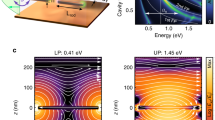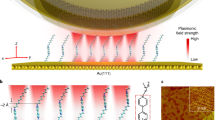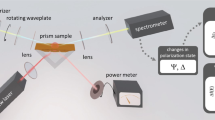Abstract
Plasmonic near-fields can be structured with sub-optical wavelength resolution. This offers promising scenarios for trapping, guiding and manipulating cold atoms in plasmonically tailored dipole potentials, which could enable strong coupling between a single atom and a single plasmonic excitation. Here, we report on the interaction of Bose–Einstein condensates with the optical near-field above plasmonic micro- and submicrometre structures. At these structures, surface plasmon polaritons are excited by a laser in the Kretschmann configuration, giving rise to resonantly enhanced surface plasmons. We introduce a technique to measure the strength of optical near-fields by observing the reflection of cold atoms from the surface. In particular, the dependence of electromagnetic field enhancement on structure size is investigated. Furthermore, we show that the near-field induced potential landscape can be tailored to sub-micrometre dimensions by demonstrating matter–wave diffraction from a grating of plasmonic wires.
This is a preview of subscription content, access via your institution
Access options
Subscribe to this journal
Receive 12 print issues and online access
$209.00 per year
only $17.42 per issue
Buy this article
- Purchase on Springer Link
- Instant access to full article PDF
Prices may be subject to local taxes which are calculated during checkout





Similar content being viewed by others
References
Wilk, T. et al. Entanglement of two individual neutral atoms using Rydberg blockade. Phys. Rev. Lett. 104, 010502 (2010).
Fortágh, J. & Zimmermann, C. Magnetic microtraps for ultracold atoms. Rev. Mod. Phys. 79, 235–289 (2007).
Grimm, R., Weidemüller, M. & Ovchinnikov, Y. B. Optical dipole traps for neutral atoms. Adv. At. Mol. Opt. Phys. 42, 95–170 (2000).
Ash, E. A. & Nicholls, G. Super-resolution aperture scanning microscope. Nature 237, 510–512 (1972).
Huang, B., Wang, W., Bates, M. & Zhuang, X. Three-dimensional super-resolution imaging by stochastic optical reconstruction microscopy. Science 319, 810–813 (2008).
Masuda, H. & Fukuda, K. Ordered metal nanohole arrays made by a two-step replication of honeycomb structures of anodic alumina. Science 268, 1466–1468 (1995).
Wang, H., Brandl, D. W., Le, F., Nordlander, P. & Halas, N. J. Nanorice: a hybrid plasmonic nanostructure. Nano Lett. 6, 827–832 (2006).
Barnes, W. L., Dereux, A. & Ebbesen, T. W. Surface plasmon subwavelength optics. Nature 424, 824–830 (2003).
Lezec, H. J. et al. Beaming light from a subwavelength aperture. Science 297, 820–822 (2002).
Homola, J., Yee, S. S. & Gauglitz, G. Surface plasmon resonance sensors: review. Sens. Actuat. B 54, 3–15 (1999).
Matveeva, E., Gryczyinski, Z., Gryczyinski, I., Malicka, J. & Lakovicz, J. R. Myoglobin immunoassay utilizing directional surface plasmon-coupled emission. Anal. Chem. 76, 6287–6292 (2004).
Haes, A. J., Hall, W. P., Chang, L., Klein, W. L. & Van Duyne, R. P. A localized surface plasmon resonance biosensor: first steps toward an assay for Alzheimer's disease. Nano Lett. 4, 1029–1034 (2004).
Jackson, J. B., Westcott, S. L., Hirsch, L. R., West, J. L. & Halas, N. J. Controlling the surface enhanced Raman effect via the nanoshell geometry. Appl. Phys. Lett. 82, 257–259 (2003).
Novotny, L. & Hafner, C. Light propagation in a cylindrical waveguide with a complex, metallic, dielectric function. Phys. Rev. E 50, 4094–4106 (1994).
Gramotnev, D. K. & Bozhevolnyi, S. I. Plasmonics beyond the diffraction limit. Nature Photon. 4, 83–91 (2010).
Zia, R. & Brongersma, M. L. Surface plasmon polariton analogue to Young's double-slit experiment. Nature Nanotech. 2, 426–429 (2007).
Min, B. et al. High-Q surface-plasmon-polariton whispering-gallery microcavity. Nature 457, 455–458 (2009).
Schuller, J. A. et al. Plasmonics for extreme light concentration and manipulation. Nature Mater. 9, 193–204 (2010).
Gather, M. C., Meerholz, K., Danz, N. & Leosson, K. Net optical gain in a plasmonic waveguide embedded in a fluorescent polymer. Nature Photon. 4, 457–461 (2010).
Chang, D. E., Sørensen, A. S., Demler, E. A. & Lukin, M. D. A single-photon transistor using nanoscale surface plasmons. Nature Phys. 3, 807–812 (2007).
Akimov, A. V. et al. Generation of single optical plasmons in metallic nanowires coupled to quantum dots. Nature 450, 402–406 (2007).
Chang, D. E. et al. Trapping and manipulation of isolated atoms using nanoscale plasmonic structures. Phys. Rev. Lett. 103, 123004 (2009).
Murphy, B. & Hau, L. V. Electro-optical nanotraps for neutral atoms. Phys. Rev. Lett. 102, 033003 (2009).
Esslinger, T., Weidemüller, M., Hemmerich, A. & Hänsch, T. W. Surface-plasmon mirror for atoms. Opt. Lett. 18, 450–452 (1993).
Feron, S. et al. Reflection of metastable neon atoms by a surface plasmon wave. Opt. Commun. 102, 83–88 (1993).
Schneble, D., Hasuo, M., Anker, T., Pfau, T. & Mlynek, J. Detection of cold metastable atoms at a surface. Rev. Sci. Instrum. 74, 2685–2689 (2003).
Gerlich, S. et al. A Kapitza–Dirac–Talbot–Lau interferometer for highly polarizable molecules. Nature Phys. 3, 711–715 (2007).
Fixler, J. B., Foster, G. T., McGuirk, J. M. & Kasevich, M. A. Atom interferometer measurement of the Newtonian constant of gravity. Science 315, 74–77 (2007).
Müller, H., Peters, A. & Chu, S. A precision measurement of the gravitational redshift by the interference of matter waves. Nature 463, 926–929 (2010).
Cronin, A. D., Schmiedmayer, J. & Pritchard, D. E. Optics and interferometry with atoms and molecules. Rev. Mod. Phys. 81, 1051–1129 (2009).
Günther, A., Kraft, S., Zimmermann, C. & Fortágh, J. Atom interferometer based on phase coherent splitting of Bose–Einstein condensates with an integrated magnetic grating. Phys. Rev. Lett. 98, 140403 (2007).
Bender, H., Courteille, P., Zimmermann, C. & Slama, S. Towards surface quantum optics with Bose–Einstein condensates in evanescent waves. Appl. Phys. B 96, 275–279 (2009).
Kretschmann, E. & Raether, H. Radiative decay of nonradiative surface plasmons excited by light. Z. Naturforsch. A 23, 2135–2136 (1968).
Sandoghdar, V., Sukenik, C. I., Hinds, E. A. & Haroche, S. Direct measurement of the van der Waals interaction between an atom and its images in a micron-sized cavity. Phys. Rev. Lett. 68, 3432–3435 (1992).
Shimizu, F. Specular reflection of very slow metastable neon atoms from a solid surface. Phys. Rev. Lett. 86, 987–990 (2001).
Druzhinina, V. & DeKieviet, M. Experimental observation of quantum reflection far from threshold. Phys. Rev. Lett. 91, 193202 (2003).
Pasquini, T. A. et al. Quantum reflection from a solid surface at normal incidence. Phys. Rev. Lett. 93, 223201 (2004).
Obrecht, J. M. et al. Measurement of the temperature dependence of the Casimir–Polder force. Phys. Rev. Lett. 98, 063201 (2007).
Bender, H., Courteille, Ph. W., Marzok, C., Zimmermann, C. & Slama, S. Direct measurement of intermediate-range Casimir–Polder potentials. Phys. Rev. Lett. 104, 083201 (2010).
Zia, R., Selker, M. D. & Brongersma, M. L. Leaky and bound modes of surface plasmon waveguides. Phys. Rev. B 71, 165431 (2005).
Acknowledgements
H.B., C.S., S.S. and C.Z. acknowledge financial support by the Deutsche Forschungsgemeinschaft within the European Collaborative Research program of the European Science Foundation. C.S. was supported by Carl-Zeiss Stiftung Baden-Württemberg. S.S. and C.S. benefited from an exchange of ideas with the European Science Foundation Research Network of New Trends and Applications of the Casimir Effects. M.F. acknowledges financial support by the European Social Fund and by the Ministry of Science, Research and the Arts Baden-Württemberg. M.F. would like to thank C. Schäfer for discussions on SU-8 and R. Löffler for exposing the mask used in the optical lithography step.
Author information
Authors and Affiliations
Contributions
S.S. designed and supervised the experiment, analysed the data and wrote the paper. H.B. and C.S. measured the data. M.F. fabricated the plasmonic structures and wrote Supplementary Section A. D.K. provided the nanofabrication lab. C.Z. provided the quantum optics lab. All authors discussed the results and commented on the manuscript at all stages.
Corresponding author
Ethics declarations
Competing interests
The authors declare no competing financial interests.
Supplementary information
Supplementary information
Supplementary information (PDF 228 kb)
Rights and permissions
About this article
Cite this article
Stehle, C., Bender, H., Zimmermann, C. et al. Plasmonically tailored micropotentials for ultracold atoms. Nature Photon 5, 494–498 (2011). https://doi.org/10.1038/nphoton.2011.159
Received:
Accepted:
Published:
Issue Date:
DOI: https://doi.org/10.1038/nphoton.2011.159
This article is cited by
-
Multifunctional logic gates based on resonant transmission at atomic-plasmonic structure
Scientific Reports (2022)
-
Dynamical Casimir–Polder force on a two-level atom with superposition state in a cavity comprising a dielectric
Scientific Reports (2020)
-
Quo vadis, plasmonic optical tweezers?
Light: Science & Applications (2019)
-
Single Plasmonic Structure Enhanced Dual-band Room Temperature Infrared Photodetection
Scientific Reports (2018)
-
Surface Plasmon Polaritons Probed with Cold Atoms
Plasmonics (2018)



